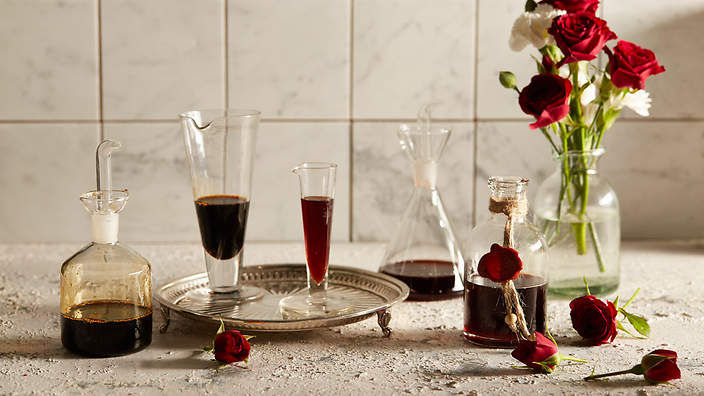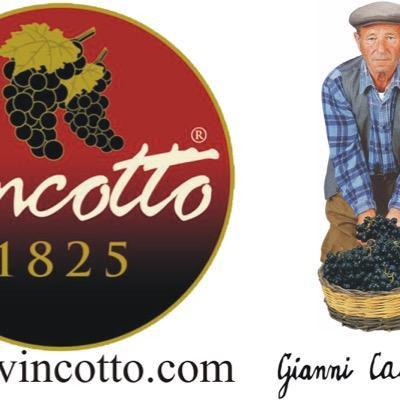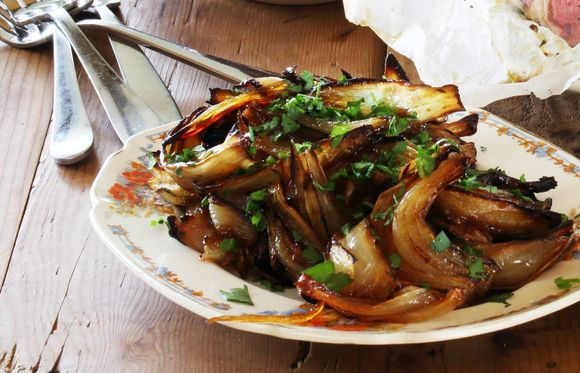Vincotto and a recipe
- rosemarydearman1
- Oct 15, 2018
- 6 min read
"Vincotto has nuances of prunes, spices, and heady grape components and is not as woody as Balsamic. " igourmet.com

On Saturday it was David's special meal and he wanted pie. So after a bit of research and mentally tossing up between two options (the other was Priddy Oggie - more about that another day) - I decided on Braised Beef Cheek and Green Peppercorn Pie from Donna Hay. Oh dear I seem to be going through a Donna Hay phase. The real reason I chose it was because it featured vincotto and I have a small bottle of this given to me by a friend some time ago, which I have not used. After this I shall be using it more I think, so thank you Marion. I didn't use beef cheek - can't get that here but a bit of research suggested tough cuts like shin or blade instead, so I found a reduced pack of gravy beef (shin I think) in the supermarket and used that. I also did not make one big pie as shown in the photo below from Donna Hay, making two smaller pies instead. David did suggest I take a photo because they did look quite good, but I declined - preferring to eat instead. Hers looks a tiny bit burnt. Mine wasn't but it wasn't as fancy either. I served it with roasted root vegetables and some beans. Both were good with it, though you could just serve a salad I guess.
So here's the recipe - because, although a tiny bit fussy, it was really good with a quite distinctive but undefinable taste. Rich and just the right texture. I halved the quantities, though I still used two sheets of puff pastry. The recipe does not appear to be online, so I'm reproducing it here. I'll come back to vincotto in a minute.

BRAISED BEEF CHEEK AND GREEN PEPPERCORN PIE
1 tbsp extra virgin olive oil
4 x 150g beef cheeks, trimmed
6 eschalots, halved (I quartered them)
1 tbsp tomato paste
1/4 cup vincotto
1 litre chicken stock
1 sprig bay leaves (about 6 leaves)
1 tbsp green peppercorns in brine, plus 2 tbsp brine liquid
1/3 cup single (pouring) cream
1 cup curly parsley leaves, chopped (I only had flat-leaf parsley)
2 x 375g sheets frozen puff pastry, thawed
1 egg
1 tbsp single pouring cream, extra
Preheat oven to 180°. Heat the oil in a large heavy-based ovenproof saucepan over medium heat. Sprinkle the beef with salt and pepper and cook for 3-4 minutes each side or until well browned. Remove from the pan and set aside. Add the eschalot to the saucepan, cook, stirring, for 4 minutes. Add the tomato paste and vincotto and cook for 2 minutes. Add the stock and bay leaves and return the beef to the pan. Stir to combine and bring to a simmer. Cover with a tight-fitting lid and transfer to the oven. Cook for 1 hour 30 minutes or until the beef is tender.
Remove the beef from the liquid and set aside. Remove and discard the bay leaves. Place the liquid over high heat, bring to the boil and cook for 12-15 minutes or until reduced. Shred the beef and return to the pan with the peppercorns, brining liquid, cream and parsley. Stir to combine and set aside.
Increase the oven temperature to 220°C. Lightly grease a 24cm round pie dish and line with 1 sheet of the pastry, trimming the edges. Fill with the beef mixture. Place the egg and extra cream in a small bowl and whisk to combine. Brush the edge of the pie with a little of the egg mixture and top with the remaining pastry. trim, crimp the edges with the handle of a spoon and brush the pastry with the egg mixture. Cut 3 x 4cm petals from the excess pastry, arrange on the pie and place on an oven tray. Cook for 10 minutes. Reduce the oven temperature to 180°C and cook for a further 20 minutes. Stand for 5 minutes before serving.
It was yummy - a little bit fancy but not Noma extreme fancy - and different. Which was really the point of my having these special meals for David. A chance to do something a bit out of my comfort zone and a little bit special.
But back to vincotto. I didn't know what to expect when I opened the bottle - but it is very thick - much thicker than balsamic vinegar to which some people liken it. I had to shake the bottle quite vigorously and for some time to get out sufficient.
It is apparently ancient. The Romans had a version. They used it in varying thicknesses as a preservative, a condiment or even as a drink - diluted with water. Which you can still do - particularly with the flavoured versions. The Romans also fermented it to make a very heady wine. In Italy Puglia seems to have become the centre of vincotto production although it is also local to Emilia Romagna (home to balsamic vinegar of course), Le Marche, Veneto and Lombardy. Which is interesting because those are all in the north of Italy and you can't really get any further south than Puglia. I wonder whether the two different areas have two different versions. I think there may be different grapes used in the north.
"Vincotto is made from grape must (containing the skins, seeds and small stems of the withered, partly dried grapes from Malvasia and Negroamaro variety). These are cooked and reduced, blended and aged in oak barrels. Like balsamic vinegar, the good stuff is aged for a number of years." All Things Sicilian and More

Obscure grape types and local to Puglia I believe. The product that seems to be most widely available is the Gianni Calogiuri Originale (there are other flavoured versions), which is the bottle shown at the top. It took a lot of searching but I finally found a history of the company and found who Gianni Calogiuri was.

The abbreviated story is that a cook to a nobleman in Naples, back in 1760 developed an early version, by boiling down the grape must. His son and grandson refined and improved it - I think the grandson (Leonardo) is the 1825 person. According to some he is the first to have produced it commercially. The grapes are reduced for 15 hours and then aged for 4 years in barrels. It was a rather more modern descendant of the family - Gianni - who decided to really produce it in commercial quantities. I'm guessing it must be a pretty large company as there really doesn't seem to be much competition.
Well - here in Australia we have the always enterprising Maggie Beer who has developed her own version with the subtly different name of vino cotto. Which, by the way means cooked wine - not that you are cooking wine - just the grapes themselves. Her version seems to have some wine vinegar added to it, and she uses shiraz grapes, and yes you can get it in your local supermarket for around $20.00. The Italian version is around $12.00 but it's only a small bottle. So this is not an ingredient that the poor are going to use to boost the flavour of their hamburgers. Nigel Slater however gives Maggie Beer a ringing endorsement:
"My favourite is Maggie Beer's [Vino Cotto]. It is my store cupboard ingredient of the year." Nigel Slater
So what can you do with it? Well thousands of different things - just browse the net - from salad dressings to improving strawberries.
"One of the best ways I could ever think to suggest adding the brilliance of Vino Cotto to your repertoire is when you find yourself with a punnet of strawberries that lack any depth of flavour, as is so often the case with the brightly coloured fruit we can all be seduced into buying purely based on visual appeal. It’s always the most disappointing thing when the flavour doesn’t stack up, but the addition of Vino Cotto changes with a wonderful alchemy that brings out every sweetness in strawberries." Maggie Beer
She also has a recipe for Baby Onions Roasted in Vino Cotto which is rather typical of lots of recipes.

SBS also had several suggestions including this delicious looking dish of glazed pork ribs and a very delicious sounding fruit bruschetta which I might try soon.

So there you go. Go to your deli, or your supermarket, be a bit extravagant and experiment. Maybe it's even better than the ubiquitous balsamic vinegar.












Comments